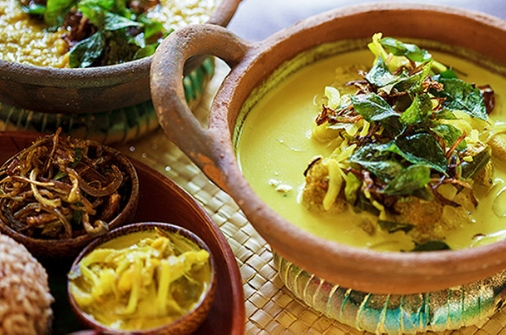
If you stand in the middle of a market in Sri Lanka your senses will be dancing. The dry heat and brightness of the sun radiate off the bright colours of fabrics. Merchants voices ring out over the crowds promoting their wares. Amongst this buzz of the market, the spices are the real star of the show.
Cloves, cardamoms, nutmeg, pepper, vanilla, ginger, lemongrass, citronella, turmeric, and curry leaves will be laid out in colourful displays that fill the air with their heavenly aromas. What you may also see is the sight of silent monks doing what appears to be begging for food. In the religion of Buddhism, monks relieve themselves of wealth and worldly possessions and commit their life to the spiritual paths of their community. What we may see as begging is actually a sacred and respected practice of giving and receiving. In Buddhist communities, monks are responsible for the spiritual well being of the community members and the community is responsible for the physical well being of the monks.

In Sri Lanka, there are multiple religions practiced and the segment sizes of religions are slowly blending with every year that passes. Buddhism is still the religion practiced by the majority of the population so for simplicity sake we will focus on the relationship of food and Buddhism today.
Giving and receiving is not thought of as a transaction. There is no giver and no receiver. The act of sharing what you have to give is considered an action that should be done without thought or expectation. It is a fluid wave within the fibers of the community. Although a monk is revered by the Buddhist community there is no separation of importance or hierarchy. Both monks and laypeople are integral parts of the community that have a symbiosis of existence. The community feeds the monks and the monks feed the souls.
They do not speak when begging. Monks only eat one meal per day and it is thought this custom has been developed so that the monks do not bother the community multiple times throughout the day. They can be seen, midday, sitting in silence making no effort to draw attention to themselves. They do not need to because the act of sharing food is a natural state in Sri Lanka.
Most Sri Lankans eat predominantly vegetarian diets. Buddhists are committed to never killing but it is also customary to never refuse food that is offered and to eat it all. For example, a vegetarian Buddhist would not refuse a meal of meat while a guest in another home. These vegetarian diets consist of large quantities of rice with an abundance of flavour options that come from the multitudes of spices and vegetables used in Sri Lankan cuisine.

It has been incorrectly perceived by the western world that there is very little variety in cuisine in Sri Lanka. Foods in Sri Lanka can be hot or very mild or can be a combination. This is very much a question of individual preference. Sri Lankan cuisine plays a vital role in the Islanders’ life from religious holidays to normal day-to-day practices. They make milk rice and special sweets with coconut milk, floor, and Honey at cultural festivals. It is recognized as one of the sixty- four types of art, “Siu Seta kalawa”. The curries come in many verities of colours and flavours blended in Sri Lankan Hot Spices which have a great ayurvedic value. Sri Lankans also like several juicy sweetmeats like Kavum, kokis, Halape, Thalaguli and Wattalapam.
Kiribath, rice cooked in coconut milk, is part of nearly every ceremonial occasion in Sri Lanka. Kawum, sweet oil cakes, and other special snacks are also popular at special events. Alcoholic beverages do not play a role in the formal rituals of Sri Lanka, being condemned by Islam, Buddhism, and Hinduism alike. Alcohol is, however, a ubiquitous part of men’s social gatherings, where beer, toddy, arrack, and kassipu (an illegally distilled beverage), are consumed in great quantities.
Sri Lanka’s culture of food is still deeply rooted in the ancient teachings of Buddhism and the underlying message of it all seems to share without thought. This is a beautiful sentiment that many of us from the western world could learn and grow from.

In March of 2020, Sacred Earth Journeys will be leading a 12 day guided tour of the sacred grounds of Sri Lanka. This journey will be led by author, spiritual teacher, and founder of the Institute of Sacred Activism, Andrew Harvey. This pilgrimage will have a central focus on Buddha and Buddhism and the many rare ancient arts and customs of Sri Lanka. We will visit the majestic beaches and the lush green nature of the surrounding area. Sri Lanka is a land of hidden treasure and unexpected beauty around every corner. If you are interested in immersing yourself in this culture of community generosity and delicious cuisine please visit our journeys page to learn all about The Sacred Heart of Sri Lanka with Andrew Harvey
~ In Sinhala, the language of the majority, Sri means “blessed” and Lanka is the name of the island. ~